Applying Freud: Addressing Child Rejection in Behavioral Science
VerifiedAdded on 2023/06/13
|10
|3364
|395
Report
AI Summary
This report delves into the issue of child rejection, particularly when a child denies a parent's role. Drawing from Freud's psychosexual development theory, it examines how childhood experiences and unconscious desires shape a child's behavior, especially in conflict-ridden environments. The report highlights the negative impact of parental maltreatment and family disputes on a child's psychological well-being. It emphasizes the importance of parents maintaining authority and guiding children through difficult situations, rather than allowing children to dictate family dynamics. The report suggests strategies for parents to address rejection, including open communication, cooperation with the other parent, and fostering a supportive environment. It stresses the need for parents to understand the child's perspective and work towards rebuilding trust and strengthening the parent-child bond through active involvement and consistent routines. The goal is to help the child navigate their emotions and develop a healthier understanding of their family relationships.

Running Head: BEHAVIORAL SCIENCE 1
Behavioral Science
Name
Institution
Behavioral Science
Name
Institution
Secure Best Marks with AI Grader
Need help grading? Try our AI Grader for instant feedback on your assignments.
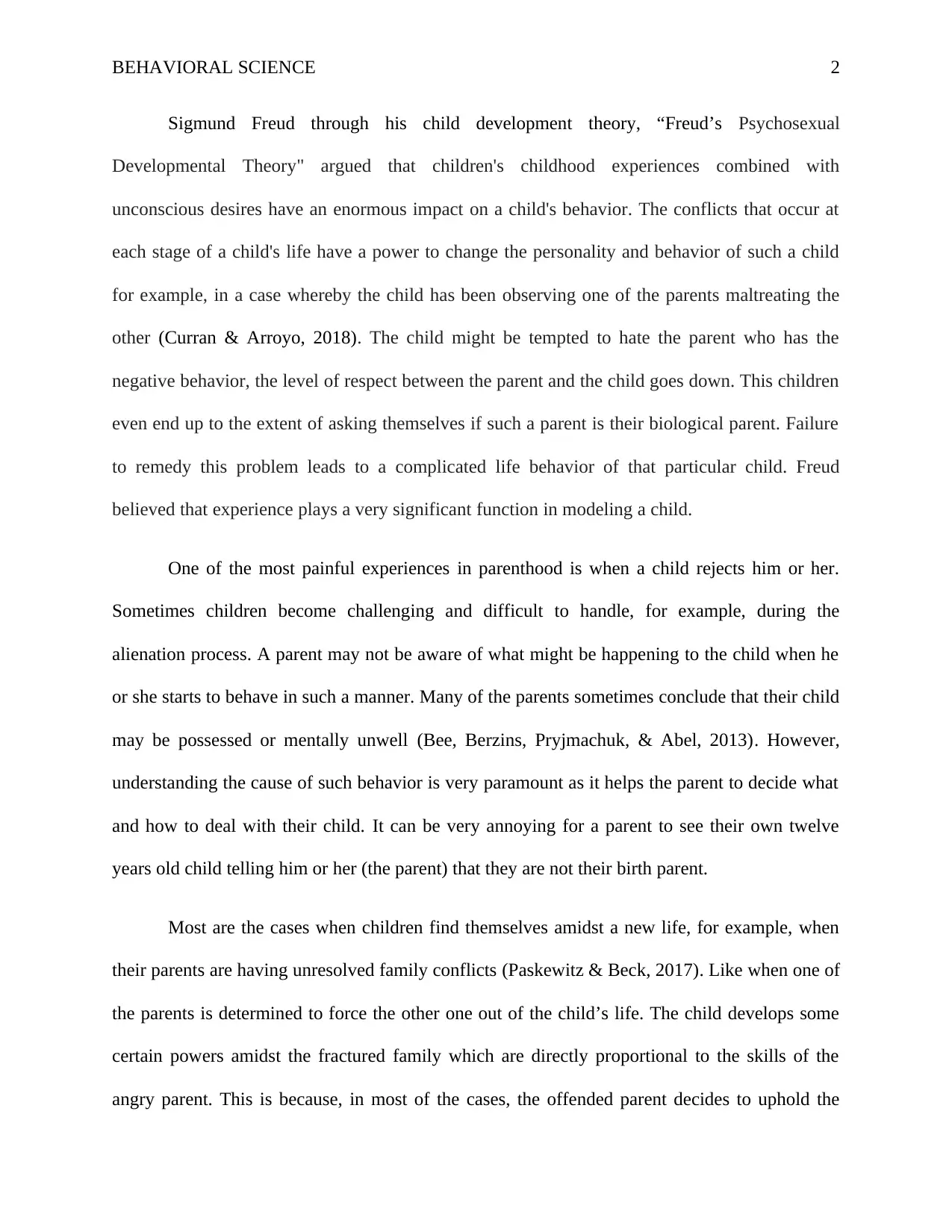
BEHAVIORAL SCIENCE 2
Sigmund Freud through his child development theory, “Freud’s Psychosexual
Developmental Theory" argued that children's childhood experiences combined with
unconscious desires have an enormous impact on a child's behavior. The conflicts that occur at
each stage of a child's life have a power to change the personality and behavior of such a child
for example, in a case whereby the child has been observing one of the parents maltreating the
other (Curran & Arroyo, 2018). The child might be tempted to hate the parent who has the
negative behavior, the level of respect between the parent and the child goes down. This children
even end up to the extent of asking themselves if such a parent is their biological parent. Failure
to remedy this problem leads to a complicated life behavior of that particular child. Freud
believed that experience plays a very significant function in modeling a child.
One of the most painful experiences in parenthood is when a child rejects him or her.
Sometimes children become challenging and difficult to handle, for example, during the
alienation process. A parent may not be aware of what might be happening to the child when he
or she starts to behave in such a manner. Many of the parents sometimes conclude that their child
may be possessed or mentally unwell (Bee, Berzins, Pryjmachuk, & Abel, 2013). However,
understanding the cause of such behavior is very paramount as it helps the parent to decide what
and how to deal with their child. It can be very annoying for a parent to see their own twelve
years old child telling him or her (the parent) that they are not their birth parent.
Most are the cases when children find themselves amidst a new life, for example, when
their parents are having unresolved family conflicts (Paskewitz & Beck, 2017). Like when one of
the parents is determined to force the other one out of the child’s life. The child develops some
certain powers amidst the fractured family which are directly proportional to the skills of the
angry parent. This is because, in most of the cases, the offended parent decides to uphold the
Sigmund Freud through his child development theory, “Freud’s Psychosexual
Developmental Theory" argued that children's childhood experiences combined with
unconscious desires have an enormous impact on a child's behavior. The conflicts that occur at
each stage of a child's life have a power to change the personality and behavior of such a child
for example, in a case whereby the child has been observing one of the parents maltreating the
other (Curran & Arroyo, 2018). The child might be tempted to hate the parent who has the
negative behavior, the level of respect between the parent and the child goes down. This children
even end up to the extent of asking themselves if such a parent is their biological parent. Failure
to remedy this problem leads to a complicated life behavior of that particular child. Freud
believed that experience plays a very significant function in modeling a child.
One of the most painful experiences in parenthood is when a child rejects him or her.
Sometimes children become challenging and difficult to handle, for example, during the
alienation process. A parent may not be aware of what might be happening to the child when he
or she starts to behave in such a manner. Many of the parents sometimes conclude that their child
may be possessed or mentally unwell (Bee, Berzins, Pryjmachuk, & Abel, 2013). However,
understanding the cause of such behavior is very paramount as it helps the parent to decide what
and how to deal with their child. It can be very annoying for a parent to see their own twelve
years old child telling him or her (the parent) that they are not their birth parent.
Most are the cases when children find themselves amidst a new life, for example, when
their parents are having unresolved family conflicts (Paskewitz & Beck, 2017). Like when one of
the parents is determined to force the other one out of the child’s life. The child develops some
certain powers amidst the fractured family which are directly proportional to the skills of the
angry parent. This is because, in most of the cases, the offended parent decides to uphold the
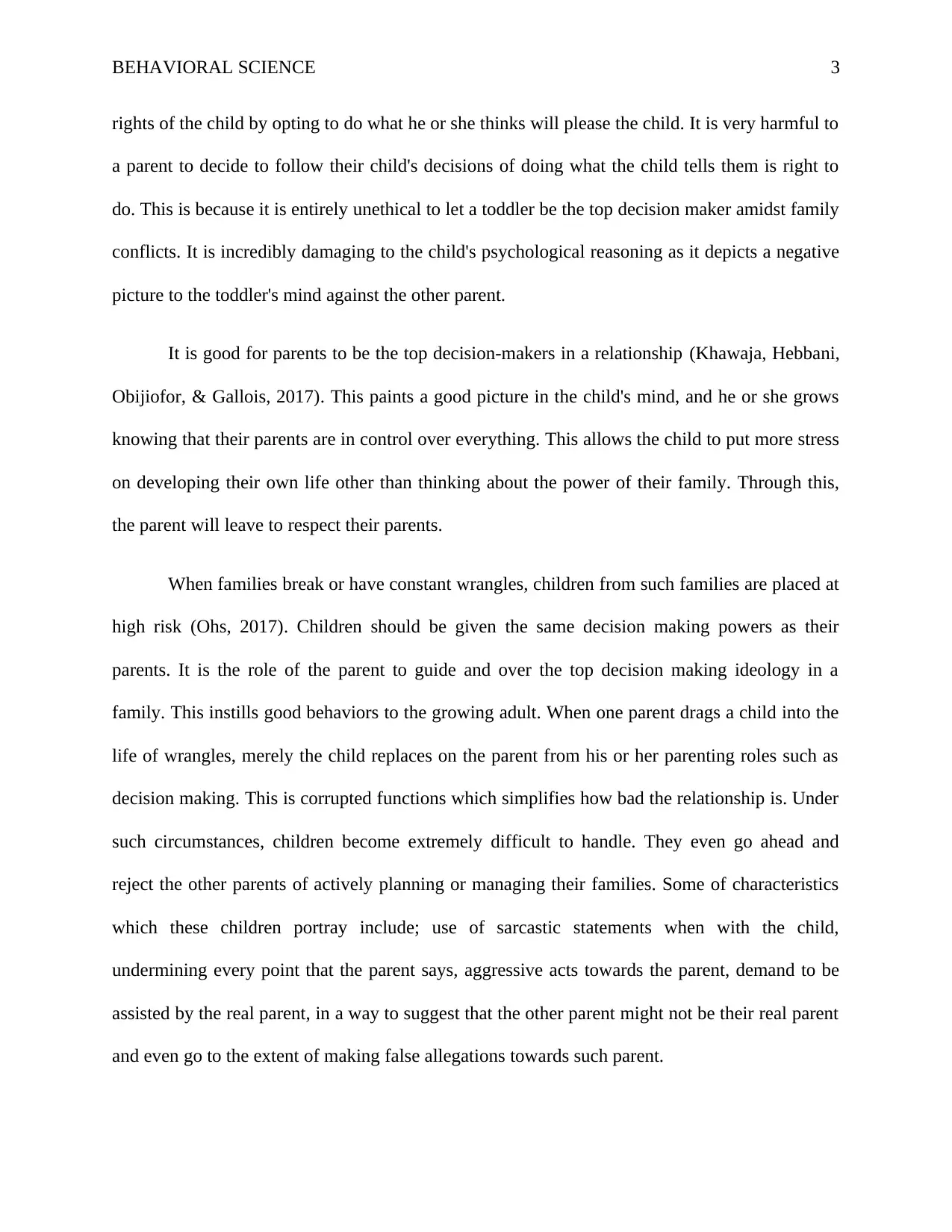
BEHAVIORAL SCIENCE 3
rights of the child by opting to do what he or she thinks will please the child. It is very harmful to
a parent to decide to follow their child's decisions of doing what the child tells them is right to
do. This is because it is entirely unethical to let a toddler be the top decision maker amidst family
conflicts. It is incredibly damaging to the child's psychological reasoning as it depicts a negative
picture to the toddler's mind against the other parent.
It is good for parents to be the top decision-makers in a relationship (Khawaja, Hebbani,
Obijiofor, & Gallois, 2017). This paints a good picture in the child's mind, and he or she grows
knowing that their parents are in control over everything. This allows the child to put more stress
on developing their own life other than thinking about the power of their family. Through this,
the parent will leave to respect their parents.
When families break or have constant wrangles, children from such families are placed at
high risk (Ohs, 2017). Children should be given the same decision making powers as their
parents. It is the role of the parent to guide and over the top decision making ideology in a
family. This instills good behaviors to the growing adult. When one parent drags a child into the
life of wrangles, merely the child replaces on the parent from his or her parenting roles such as
decision making. This is corrupted functions which simplifies how bad the relationship is. Under
such circumstances, children become extremely difficult to handle. They even go ahead and
reject the other parents of actively planning or managing their families. Some of characteristics
which these children portray include; use of sarcastic statements when with the child,
undermining every point that the parent says, aggressive acts towards the parent, demand to be
assisted by the real parent, in a way to suggest that the other parent might not be their real parent
and even go to the extent of making false allegations towards such parent.
rights of the child by opting to do what he or she thinks will please the child. It is very harmful to
a parent to decide to follow their child's decisions of doing what the child tells them is right to
do. This is because it is entirely unethical to let a toddler be the top decision maker amidst family
conflicts. It is incredibly damaging to the child's psychological reasoning as it depicts a negative
picture to the toddler's mind against the other parent.
It is good for parents to be the top decision-makers in a relationship (Khawaja, Hebbani,
Obijiofor, & Gallois, 2017). This paints a good picture in the child's mind, and he or she grows
knowing that their parents are in control over everything. This allows the child to put more stress
on developing their own life other than thinking about the power of their family. Through this,
the parent will leave to respect their parents.
When families break or have constant wrangles, children from such families are placed at
high risk (Ohs, 2017). Children should be given the same decision making powers as their
parents. It is the role of the parent to guide and over the top decision making ideology in a
family. This instills good behaviors to the growing adult. When one parent drags a child into the
life of wrangles, merely the child replaces on the parent from his or her parenting roles such as
decision making. This is corrupted functions which simplifies how bad the relationship is. Under
such circumstances, children become extremely difficult to handle. They even go ahead and
reject the other parents of actively planning or managing their families. Some of characteristics
which these children portray include; use of sarcastic statements when with the child,
undermining every point that the parent says, aggressive acts towards the parent, demand to be
assisted by the real parent, in a way to suggest that the other parent might not be their real parent
and even go to the extent of making false allegations towards such parent.
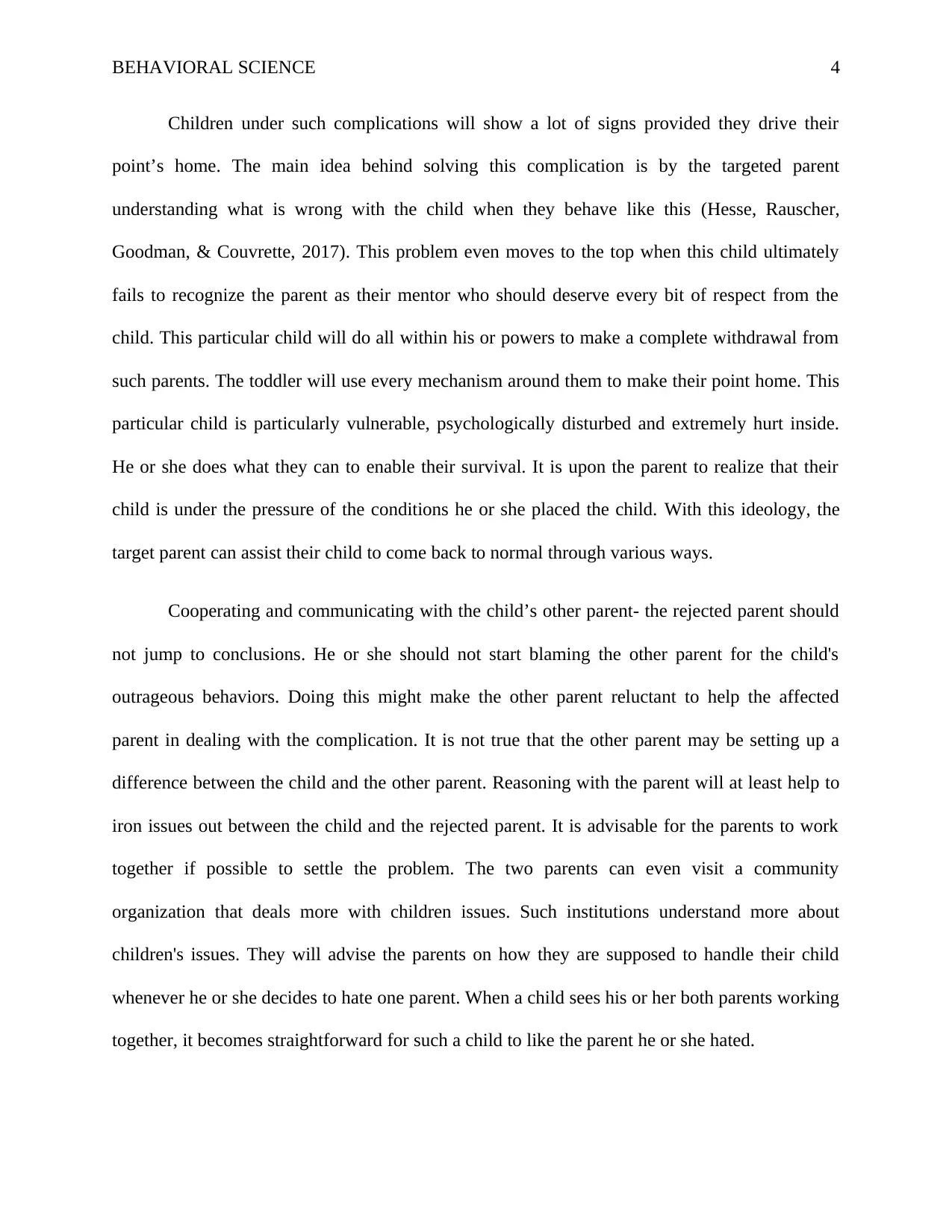
BEHAVIORAL SCIENCE 4
Children under such complications will show a lot of signs provided they drive their
point’s home. The main idea behind solving this complication is by the targeted parent
understanding what is wrong with the child when they behave like this (Hesse, Rauscher,
Goodman, & Couvrette, 2017). This problem even moves to the top when this child ultimately
fails to recognize the parent as their mentor who should deserve every bit of respect from the
child. This particular child will do all within his or powers to make a complete withdrawal from
such parents. The toddler will use every mechanism around them to make their point home. This
particular child is particularly vulnerable, psychologically disturbed and extremely hurt inside.
He or she does what they can to enable their survival. It is upon the parent to realize that their
child is under the pressure of the conditions he or she placed the child. With this ideology, the
target parent can assist their child to come back to normal through various ways.
Cooperating and communicating with the child’s other parent- the rejected parent should
not jump to conclusions. He or she should not start blaming the other parent for the child's
outrageous behaviors. Doing this might make the other parent reluctant to help the affected
parent in dealing with the complication. It is not true that the other parent may be setting up a
difference between the child and the other parent. Reasoning with the parent will at least help to
iron issues out between the child and the rejected parent. It is advisable for the parents to work
together if possible to settle the problem. The two parents can even visit a community
organization that deals more with children issues. Such institutions understand more about
children's issues. They will advise the parents on how they are supposed to handle their child
whenever he or she decides to hate one parent. When a child sees his or her both parents working
together, it becomes straightforward for such a child to like the parent he or she hated.
Children under such complications will show a lot of signs provided they drive their
point’s home. The main idea behind solving this complication is by the targeted parent
understanding what is wrong with the child when they behave like this (Hesse, Rauscher,
Goodman, & Couvrette, 2017). This problem even moves to the top when this child ultimately
fails to recognize the parent as their mentor who should deserve every bit of respect from the
child. This particular child will do all within his or powers to make a complete withdrawal from
such parents. The toddler will use every mechanism around them to make their point home. This
particular child is particularly vulnerable, psychologically disturbed and extremely hurt inside.
He or she does what they can to enable their survival. It is upon the parent to realize that their
child is under the pressure of the conditions he or she placed the child. With this ideology, the
target parent can assist their child to come back to normal through various ways.
Cooperating and communicating with the child’s other parent- the rejected parent should
not jump to conclusions. He or she should not start blaming the other parent for the child's
outrageous behaviors. Doing this might make the other parent reluctant to help the affected
parent in dealing with the complication. It is not true that the other parent may be setting up a
difference between the child and the other parent. Reasoning with the parent will at least help to
iron issues out between the child and the rejected parent. It is advisable for the parents to work
together if possible to settle the problem. The two parents can even visit a community
organization that deals more with children issues. Such institutions understand more about
children's issues. They will advise the parents on how they are supposed to handle their child
whenever he or she decides to hate one parent. When a child sees his or her both parents working
together, it becomes straightforward for such a child to like the parent he or she hated.
Secure Best Marks with AI Grader
Need help grading? Try our AI Grader for instant feedback on your assignments.
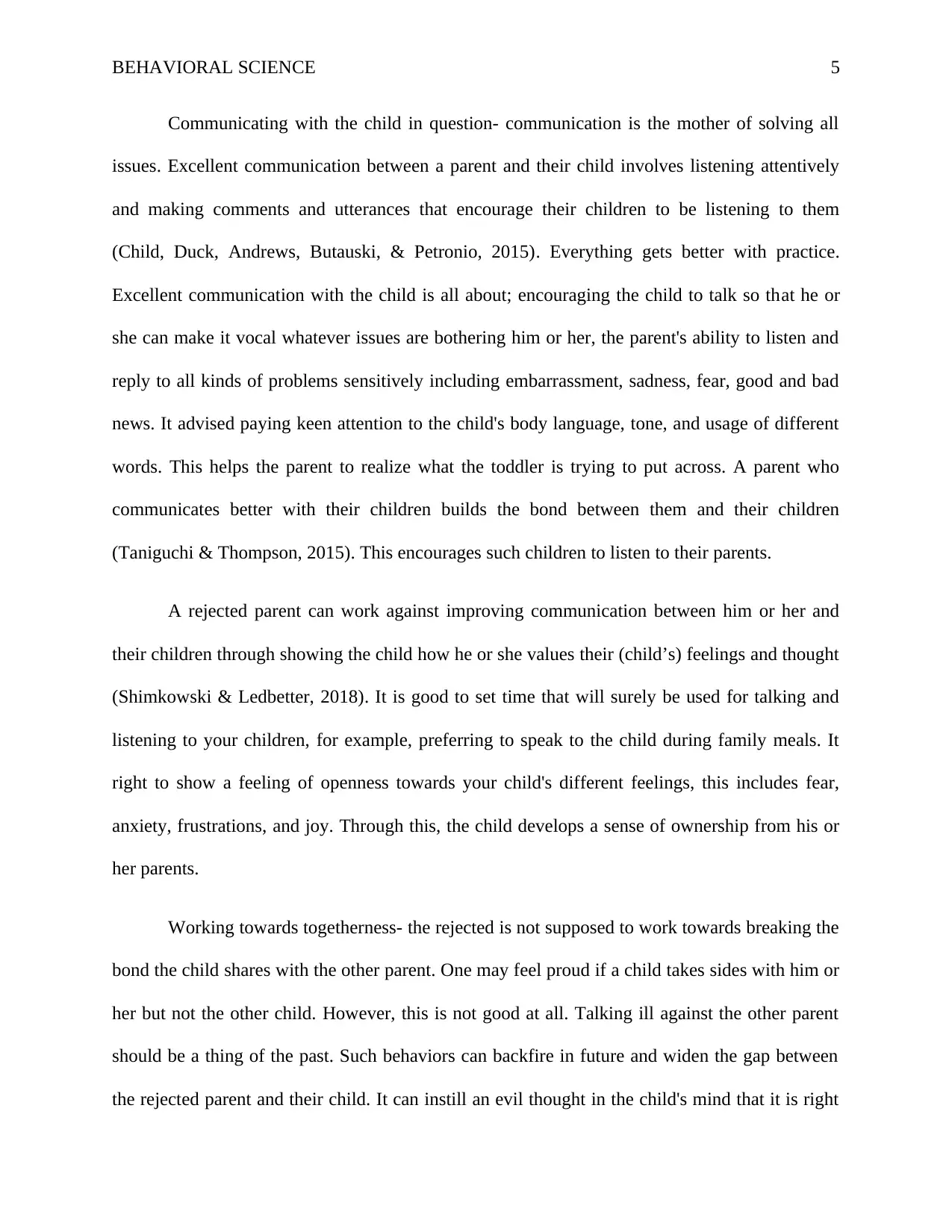
BEHAVIORAL SCIENCE 5
Communicating with the child in question- communication is the mother of solving all
issues. Excellent communication between a parent and their child involves listening attentively
and making comments and utterances that encourage their children to be listening to them
(Child, Duck, Andrews, Butauski, & Petronio, 2015). Everything gets better with practice.
Excellent communication with the child is all about; encouraging the child to talk so that he or
she can make it vocal whatever issues are bothering him or her, the parent's ability to listen and
reply to all kinds of problems sensitively including embarrassment, sadness, fear, good and bad
news. It advised paying keen attention to the child's body language, tone, and usage of different
words. This helps the parent to realize what the toddler is trying to put across. A parent who
communicates better with their children builds the bond between them and their children
(Taniguchi & Thompson, 2015). This encourages such children to listen to their parents.
A rejected parent can work against improving communication between him or her and
their children through showing the child how he or she values their (child’s) feelings and thought
(Shimkowski & Ledbetter, 2018). It is good to set time that will surely be used for talking and
listening to your children, for example, preferring to speak to the child during family meals. It
right to show a feeling of openness towards your child's different feelings, this includes fear,
anxiety, frustrations, and joy. Through this, the child develops a sense of ownership from his or
her parents.
Working towards togetherness- the rejected is not supposed to work towards breaking the
bond the child shares with the other parent. One may feel proud if a child takes sides with him or
her but not the other child. However, this is not good at all. Talking ill against the other parent
should be a thing of the past. Such behaviors can backfire in future and widen the gap between
the rejected parent and their child. It can instill an evil thought in the child's mind that it is right
Communicating with the child in question- communication is the mother of solving all
issues. Excellent communication between a parent and their child involves listening attentively
and making comments and utterances that encourage their children to be listening to them
(Child, Duck, Andrews, Butauski, & Petronio, 2015). Everything gets better with practice.
Excellent communication with the child is all about; encouraging the child to talk so that he or
she can make it vocal whatever issues are bothering him or her, the parent's ability to listen and
reply to all kinds of problems sensitively including embarrassment, sadness, fear, good and bad
news. It advised paying keen attention to the child's body language, tone, and usage of different
words. This helps the parent to realize what the toddler is trying to put across. A parent who
communicates better with their children builds the bond between them and their children
(Taniguchi & Thompson, 2015). This encourages such children to listen to their parents.
A rejected parent can work against improving communication between him or her and
their children through showing the child how he or she values their (child’s) feelings and thought
(Shimkowski & Ledbetter, 2018). It is good to set time that will surely be used for talking and
listening to your children, for example, preferring to speak to the child during family meals. It
right to show a feeling of openness towards your child's different feelings, this includes fear,
anxiety, frustrations, and joy. Through this, the child develops a sense of ownership from his or
her parents.
Working towards togetherness- the rejected is not supposed to work towards breaking the
bond the child shares with the other parent. One may feel proud if a child takes sides with him or
her but not the other child. However, this is not good at all. Talking ill against the other parent
should be a thing of the past. Such behaviors can backfire in future and widen the gap between
the rejected parent and their child. It can instill an evil thought in the child's mind that it is right
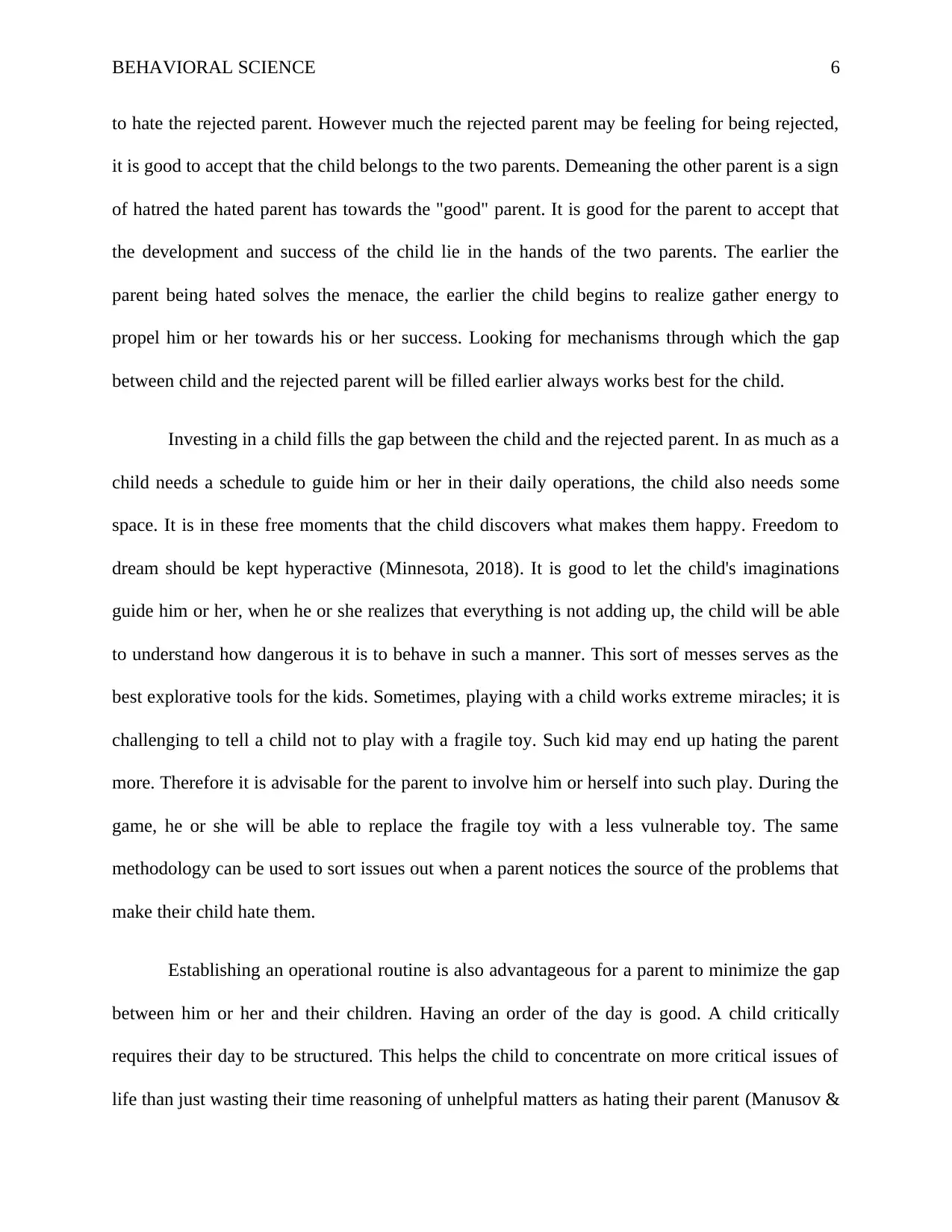
BEHAVIORAL SCIENCE 6
to hate the rejected parent. However much the rejected parent may be feeling for being rejected,
it is good to accept that the child belongs to the two parents. Demeaning the other parent is a sign
of hatred the hated parent has towards the "good" parent. It is good for the parent to accept that
the development and success of the child lie in the hands of the two parents. The earlier the
parent being hated solves the menace, the earlier the child begins to realize gather energy to
propel him or her towards his or her success. Looking for mechanisms through which the gap
between child and the rejected parent will be filled earlier always works best for the child.
Investing in a child fills the gap between the child and the rejected parent. In as much as a
child needs a schedule to guide him or her in their daily operations, the child also needs some
space. It is in these free moments that the child discovers what makes them happy. Freedom to
dream should be kept hyperactive (Minnesota, 2018). It is good to let the child's imaginations
guide him or her, when he or she realizes that everything is not adding up, the child will be able
to understand how dangerous it is to behave in such a manner. This sort of messes serves as the
best explorative tools for the kids. Sometimes, playing with a child works extreme miracles; it is
challenging to tell a child not to play with a fragile toy. Such kid may end up hating the parent
more. Therefore it is advisable for the parent to involve him or herself into such play. During the
game, he or she will be able to replace the fragile toy with a less vulnerable toy. The same
methodology can be used to sort issues out when a parent notices the source of the problems that
make their child hate them.
Establishing an operational routine is also advantageous for a parent to minimize the gap
between him or her and their children. Having an order of the day is good. A child critically
requires their day to be structured. This helps the child to concentrate on more critical issues of
life than just wasting their time reasoning of unhelpful matters as hating their parent (Manusov &
to hate the rejected parent. However much the rejected parent may be feeling for being rejected,
it is good to accept that the child belongs to the two parents. Demeaning the other parent is a sign
of hatred the hated parent has towards the "good" parent. It is good for the parent to accept that
the development and success of the child lie in the hands of the two parents. The earlier the
parent being hated solves the menace, the earlier the child begins to realize gather energy to
propel him or her towards his or her success. Looking for mechanisms through which the gap
between child and the rejected parent will be filled earlier always works best for the child.
Investing in a child fills the gap between the child and the rejected parent. In as much as a
child needs a schedule to guide him or her in their daily operations, the child also needs some
space. It is in these free moments that the child discovers what makes them happy. Freedom to
dream should be kept hyperactive (Minnesota, 2018). It is good to let the child's imaginations
guide him or her, when he or she realizes that everything is not adding up, the child will be able
to understand how dangerous it is to behave in such a manner. This sort of messes serves as the
best explorative tools for the kids. Sometimes, playing with a child works extreme miracles; it is
challenging to tell a child not to play with a fragile toy. Such kid may end up hating the parent
more. Therefore it is advisable for the parent to involve him or herself into such play. During the
game, he or she will be able to replace the fragile toy with a less vulnerable toy. The same
methodology can be used to sort issues out when a parent notices the source of the problems that
make their child hate them.
Establishing an operational routine is also advantageous for a parent to minimize the gap
between him or her and their children. Having an order of the day is good. A child critically
requires their day to be structured. This helps the child to concentrate on more critical issues of
life than just wasting their time reasoning of unhelpful matters as hating their parent (Manusov &
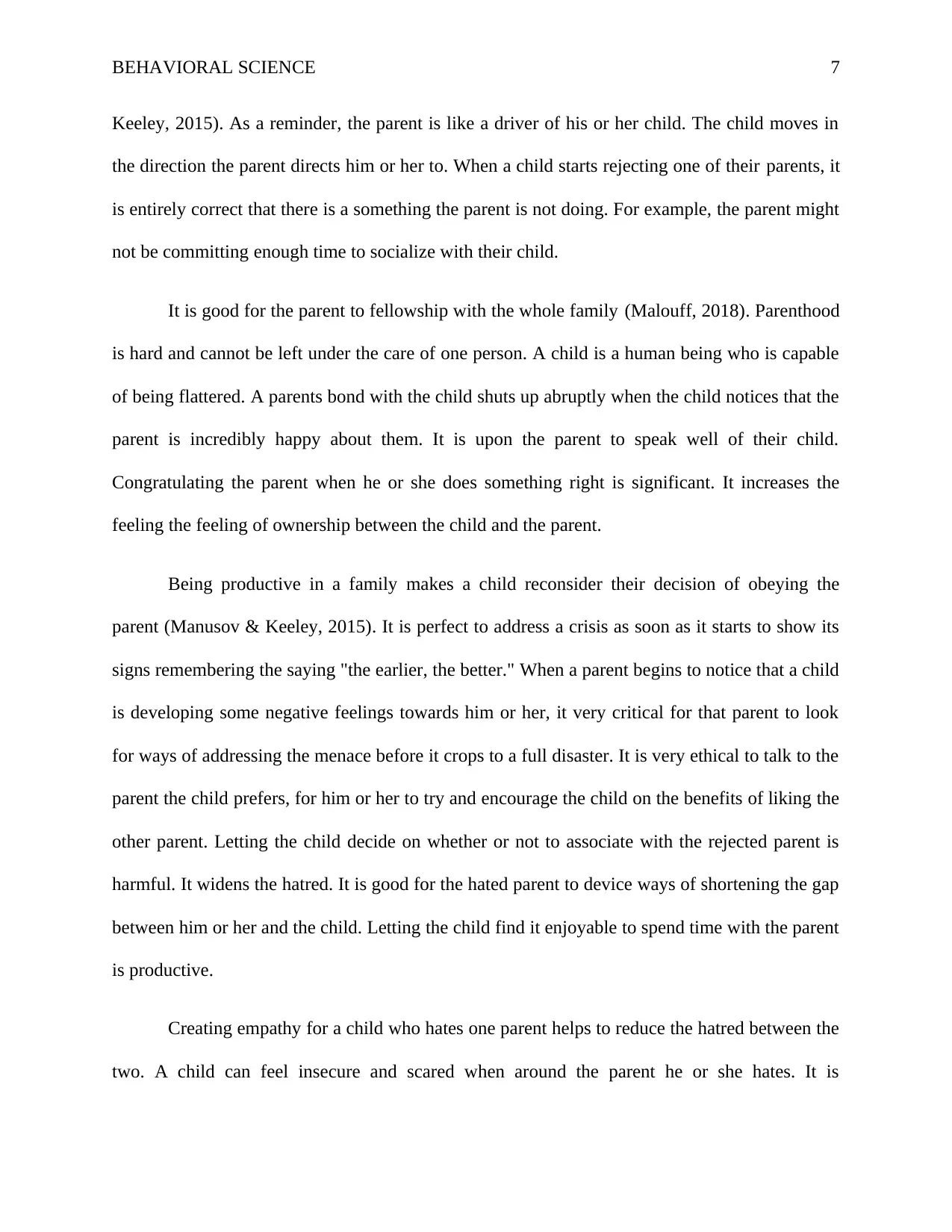
BEHAVIORAL SCIENCE 7
Keeley, 2015). As a reminder, the parent is like a driver of his or her child. The child moves in
the direction the parent directs him or her to. When a child starts rejecting one of their parents, it
is entirely correct that there is a something the parent is not doing. For example, the parent might
not be committing enough time to socialize with their child.
It is good for the parent to fellowship with the whole family (Malouff, 2018). Parenthood
is hard and cannot be left under the care of one person. A child is a human being who is capable
of being flattered. A parents bond with the child shuts up abruptly when the child notices that the
parent is incredibly happy about them. It is upon the parent to speak well of their child.
Congratulating the parent when he or she does something right is significant. It increases the
feeling the feeling of ownership between the child and the parent.
Being productive in a family makes a child reconsider their decision of obeying the
parent (Manusov & Keeley, 2015). It is perfect to address a crisis as soon as it starts to show its
signs remembering the saying "the earlier, the better." When a parent begins to notice that a child
is developing some negative feelings towards him or her, it very critical for that parent to look
for ways of addressing the menace before it crops to a full disaster. It is very ethical to talk to the
parent the child prefers, for him or her to try and encourage the child on the benefits of liking the
other parent. Letting the child decide on whether or not to associate with the rejected parent is
harmful. It widens the hatred. It is good for the hated parent to device ways of shortening the gap
between him or her and the child. Letting the child find it enjoyable to spend time with the parent
is productive.
Creating empathy for a child who hates one parent helps to reduce the hatred between the
two. A child can feel insecure and scared when around the parent he or she hates. It is
Keeley, 2015). As a reminder, the parent is like a driver of his or her child. The child moves in
the direction the parent directs him or her to. When a child starts rejecting one of their parents, it
is entirely correct that there is a something the parent is not doing. For example, the parent might
not be committing enough time to socialize with their child.
It is good for the parent to fellowship with the whole family (Malouff, 2018). Parenthood
is hard and cannot be left under the care of one person. A child is a human being who is capable
of being flattered. A parents bond with the child shuts up abruptly when the child notices that the
parent is incredibly happy about them. It is upon the parent to speak well of their child.
Congratulating the parent when he or she does something right is significant. It increases the
feeling the feeling of ownership between the child and the parent.
Being productive in a family makes a child reconsider their decision of obeying the
parent (Manusov & Keeley, 2015). It is perfect to address a crisis as soon as it starts to show its
signs remembering the saying "the earlier, the better." When a parent begins to notice that a child
is developing some negative feelings towards him or her, it very critical for that parent to look
for ways of addressing the menace before it crops to a full disaster. It is very ethical to talk to the
parent the child prefers, for him or her to try and encourage the child on the benefits of liking the
other parent. Letting the child decide on whether or not to associate with the rejected parent is
harmful. It widens the hatred. It is good for the hated parent to device ways of shortening the gap
between him or her and the child. Letting the child find it enjoyable to spend time with the parent
is productive.
Creating empathy for a child who hates one parent helps to reduce the hatred between the
two. A child can feel insecure and scared when around the parent he or she hates. It is
Paraphrase This Document
Need a fresh take? Get an instant paraphrase of this document with our AI Paraphraser
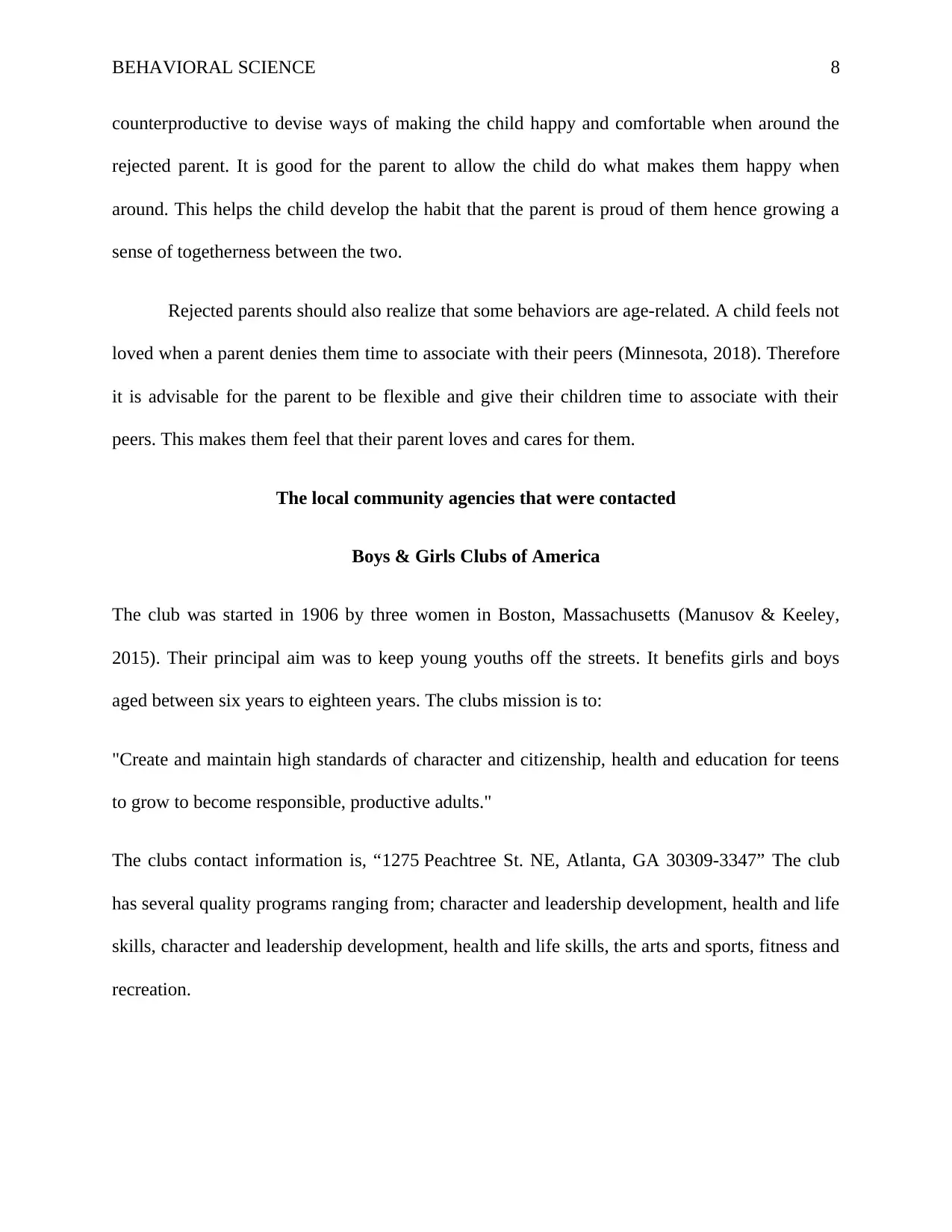
BEHAVIORAL SCIENCE 8
counterproductive to devise ways of making the child happy and comfortable when around the
rejected parent. It is good for the parent to allow the child do what makes them happy when
around. This helps the child develop the habit that the parent is proud of them hence growing a
sense of togetherness between the two.
Rejected parents should also realize that some behaviors are age-related. A child feels not
loved when a parent denies them time to associate with their peers (Minnesota, 2018). Therefore
it is advisable for the parent to be flexible and give their children time to associate with their
peers. This makes them feel that their parent loves and cares for them.
The local community agencies that were contacted
Boys & Girls Clubs of America
The club was started in 1906 by three women in Boston, Massachusetts (Manusov & Keeley,
2015). Their principal aim was to keep young youths off the streets. It benefits girls and boys
aged between six years to eighteen years. The clubs mission is to:
"Create and maintain high standards of character and citizenship, health and education for teens
to grow to become responsible, productive adults."
The clubs contact information is, “1275 Peachtree St. NE, Atlanta, GA 30309-3347” The club
has several quality programs ranging from; character and leadership development, health and life
skills, character and leadership development, health and life skills, the arts and sports, fitness and
recreation.
counterproductive to devise ways of making the child happy and comfortable when around the
rejected parent. It is good for the parent to allow the child do what makes them happy when
around. This helps the child develop the habit that the parent is proud of them hence growing a
sense of togetherness between the two.
Rejected parents should also realize that some behaviors are age-related. A child feels not
loved when a parent denies them time to associate with their peers (Minnesota, 2018). Therefore
it is advisable for the parent to be flexible and give their children time to associate with their
peers. This makes them feel that their parent loves and cares for them.
The local community agencies that were contacted
Boys & Girls Clubs of America
The club was started in 1906 by three women in Boston, Massachusetts (Manusov & Keeley,
2015). Their principal aim was to keep young youths off the streets. It benefits girls and boys
aged between six years to eighteen years. The clubs mission is to:
"Create and maintain high standards of character and citizenship, health and education for teens
to grow to become responsible, productive adults."
The clubs contact information is, “1275 Peachtree St. NE, Atlanta, GA 30309-3347” The club
has several quality programs ranging from; character and leadership development, health and life
skills, character and leadership development, health and life skills, the arts and sports, fitness and
recreation.
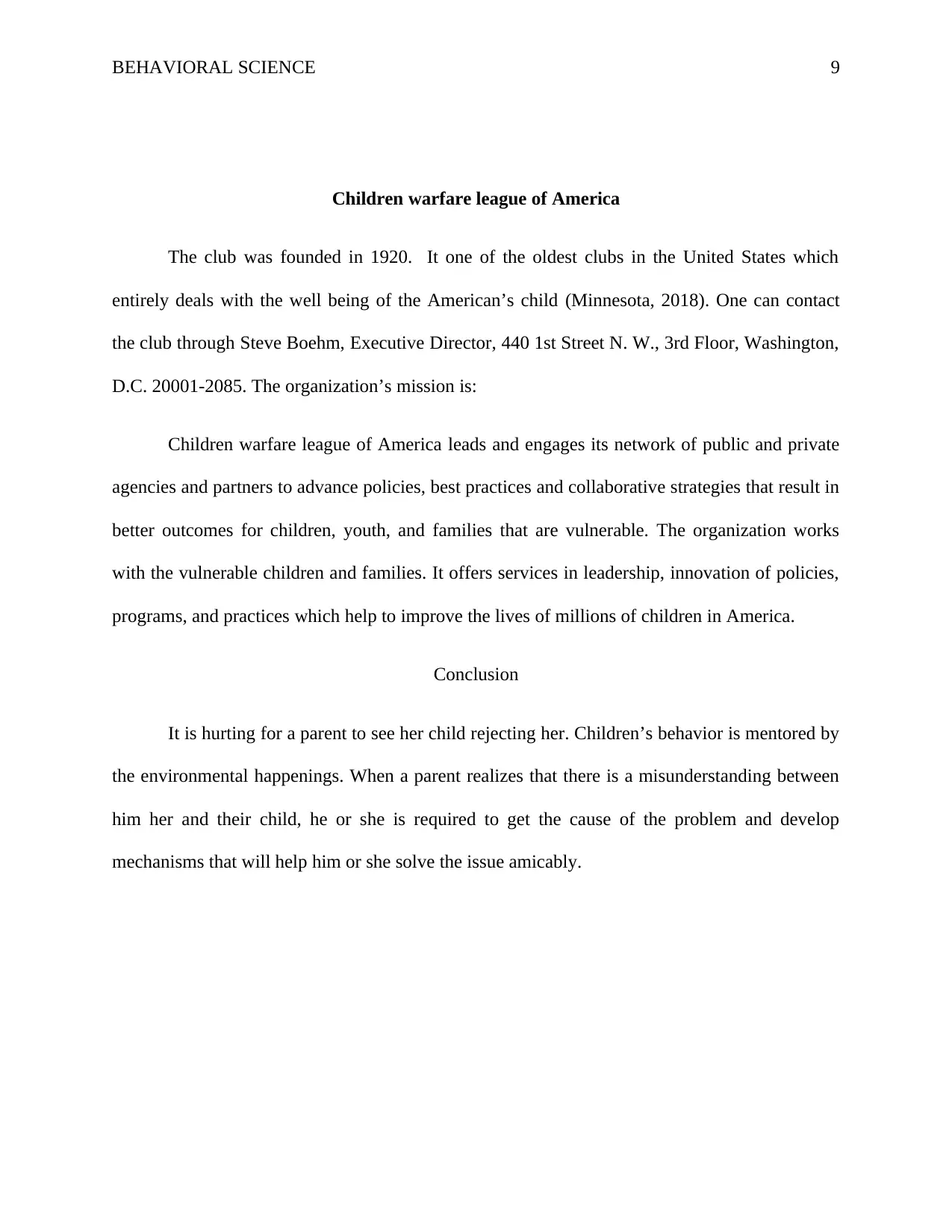
BEHAVIORAL SCIENCE 9
Children warfare league of America
The club was founded in 1920. It one of the oldest clubs in the United States which
entirely deals with the well being of the American’s child (Minnesota, 2018). One can contact
the club through Steve Boehm, Executive Director, 440 1st Street N. W., 3rd Floor, Washington,
D.C. 20001-2085. The organization’s mission is:
Children warfare league of America leads and engages its network of public and private
agencies and partners to advance policies, best practices and collaborative strategies that result in
better outcomes for children, youth, and families that are vulnerable. The organization works
with the vulnerable children and families. It offers services in leadership, innovation of policies,
programs, and practices which help to improve the lives of millions of children in America.
Conclusion
It is hurting for a parent to see her child rejecting her. Children’s behavior is mentored by
the environmental happenings. When a parent realizes that there is a misunderstanding between
him her and their child, he or she is required to get the cause of the problem and develop
mechanisms that will help him or she solve the issue amicably.
Children warfare league of America
The club was founded in 1920. It one of the oldest clubs in the United States which
entirely deals with the well being of the American’s child (Minnesota, 2018). One can contact
the club through Steve Boehm, Executive Director, 440 1st Street N. W., 3rd Floor, Washington,
D.C. 20001-2085. The organization’s mission is:
Children warfare league of America leads and engages its network of public and private
agencies and partners to advance policies, best practices and collaborative strategies that result in
better outcomes for children, youth, and families that are vulnerable. The organization works
with the vulnerable children and families. It offers services in leadership, innovation of policies,
programs, and practices which help to improve the lives of millions of children in America.
Conclusion
It is hurting for a parent to see her child rejecting her. Children’s behavior is mentored by
the environmental happenings. When a parent realizes that there is a misunderstanding between
him her and their child, he or she is required to get the cause of the problem and develop
mechanisms that will help him or she solve the issue amicably.
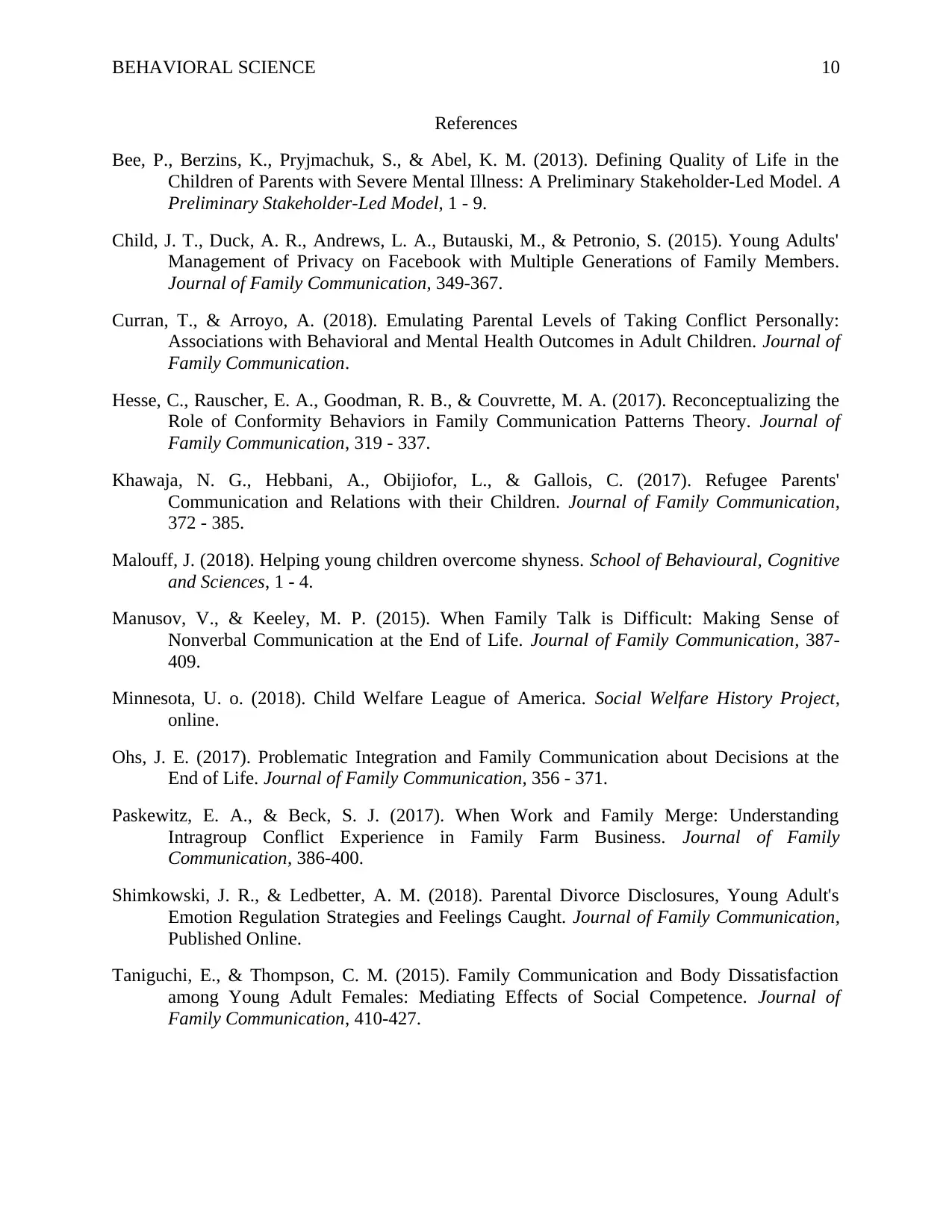
BEHAVIORAL SCIENCE 10
References
Bee, P., Berzins, K., Pryjmachuk, S., & Abel, K. M. (2013). Defining Quality of Life in the
Children of Parents with Severe Mental Illness: A Preliminary Stakeholder-Led Model. A
Preliminary Stakeholder-Led Model, 1 - 9.
Child, J. T., Duck, A. R., Andrews, L. A., Butauski, M., & Petronio, S. (2015). Young Adults'
Management of Privacy on Facebook with Multiple Generations of Family Members.
Journal of Family Communication, 349-367.
Curran, T., & Arroyo, A. (2018). Emulating Parental Levels of Taking Conflict Personally:
Associations with Behavioral and Mental Health Outcomes in Adult Children. Journal of
Family Communication.
Hesse, C., Rauscher, E. A., Goodman, R. B., & Couvrette, M. A. (2017). Reconceptualizing the
Role of Conformity Behaviors in Family Communication Patterns Theory. Journal of
Family Communication, 319 - 337.
Khawaja, N. G., Hebbani, A., Obijiofor, L., & Gallois, C. (2017). Refugee Parents'
Communication and Relations with their Children. Journal of Family Communication,
372 - 385.
Malouff, J. (2018). Helping young children overcome shyness. School of Behavioural, Cognitive
and Sciences, 1 - 4.
Manusov, V., & Keeley, M. P. (2015). When Family Talk is Difficult: Making Sense of
Nonverbal Communication at the End of Life. Journal of Family Communication, 387-
409.
Minnesota, U. o. (2018). Child Welfare League of America. Social Welfare History Project,
online.
Ohs, J. E. (2017). Problematic Integration and Family Communication about Decisions at the
End of Life. Journal of Family Communication, 356 - 371.
Paskewitz, E. A., & Beck, S. J. (2017). When Work and Family Merge: Understanding
Intragroup Conflict Experience in Family Farm Business. Journal of Family
Communication, 386-400.
Shimkowski, J. R., & Ledbetter, A. M. (2018). Parental Divorce Disclosures, Young Adult's
Emotion Regulation Strategies and Feelings Caught. Journal of Family Communication,
Published Online.
Taniguchi, E., & Thompson, C. M. (2015). Family Communication and Body Dissatisfaction
among Young Adult Females: Mediating Effects of Social Competence. Journal of
Family Communication, 410-427.
References
Bee, P., Berzins, K., Pryjmachuk, S., & Abel, K. M. (2013). Defining Quality of Life in the
Children of Parents with Severe Mental Illness: A Preliminary Stakeholder-Led Model. A
Preliminary Stakeholder-Led Model, 1 - 9.
Child, J. T., Duck, A. R., Andrews, L. A., Butauski, M., & Petronio, S. (2015). Young Adults'
Management of Privacy on Facebook with Multiple Generations of Family Members.
Journal of Family Communication, 349-367.
Curran, T., & Arroyo, A. (2018). Emulating Parental Levels of Taking Conflict Personally:
Associations with Behavioral and Mental Health Outcomes in Adult Children. Journal of
Family Communication.
Hesse, C., Rauscher, E. A., Goodman, R. B., & Couvrette, M. A. (2017). Reconceptualizing the
Role of Conformity Behaviors in Family Communication Patterns Theory. Journal of
Family Communication, 319 - 337.
Khawaja, N. G., Hebbani, A., Obijiofor, L., & Gallois, C. (2017). Refugee Parents'
Communication and Relations with their Children. Journal of Family Communication,
372 - 385.
Malouff, J. (2018). Helping young children overcome shyness. School of Behavioural, Cognitive
and Sciences, 1 - 4.
Manusov, V., & Keeley, M. P. (2015). When Family Talk is Difficult: Making Sense of
Nonverbal Communication at the End of Life. Journal of Family Communication, 387-
409.
Minnesota, U. o. (2018). Child Welfare League of America. Social Welfare History Project,
online.
Ohs, J. E. (2017). Problematic Integration and Family Communication about Decisions at the
End of Life. Journal of Family Communication, 356 - 371.
Paskewitz, E. A., & Beck, S. J. (2017). When Work and Family Merge: Understanding
Intragroup Conflict Experience in Family Farm Business. Journal of Family
Communication, 386-400.
Shimkowski, J. R., & Ledbetter, A. M. (2018). Parental Divorce Disclosures, Young Adult's
Emotion Regulation Strategies and Feelings Caught. Journal of Family Communication,
Published Online.
Taniguchi, E., & Thompson, C. M. (2015). Family Communication and Body Dissatisfaction
among Young Adult Females: Mediating Effects of Social Competence. Journal of
Family Communication, 410-427.
1 out of 10
Related Documents
Your All-in-One AI-Powered Toolkit for Academic Success.
+13062052269
info@desklib.com
Available 24*7 on WhatsApp / Email
![[object Object]](/_next/static/media/star-bottom.7253800d.svg)
Unlock your academic potential
© 2024 | Zucol Services PVT LTD | All rights reserved.





